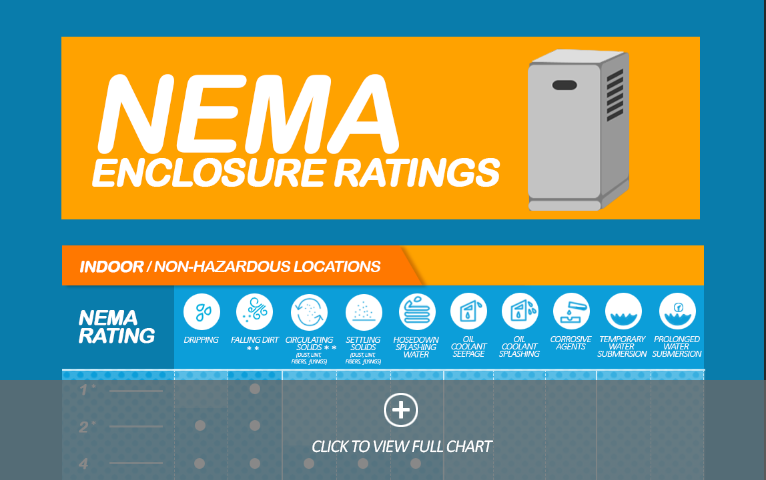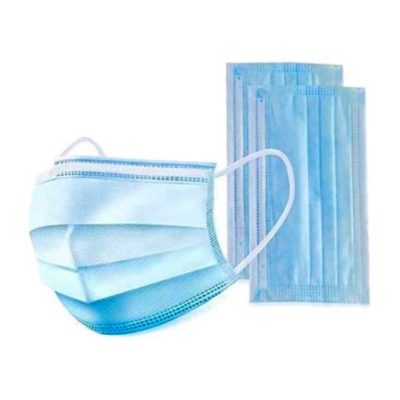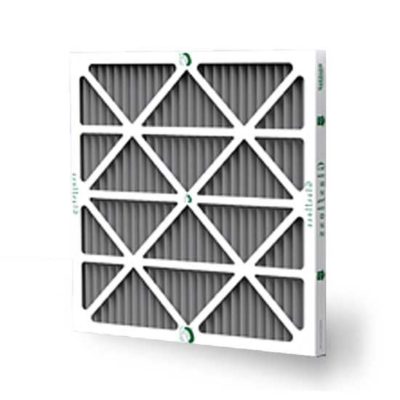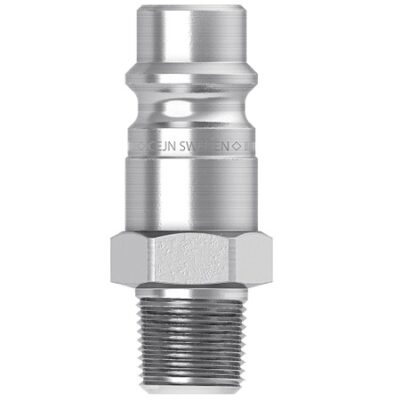The use of enclosure coolers has grown exponentially due to the demands created by higher cabinet heat loads associated with more sophisticated electrical equipment.
In an attempt to lower costs, manufacturers placed equipment closer to the plant, exposing it to harsher environments. Before the invention of enclosure coolers in the 1960s, electrical enclosures relied solely on ventilation and many components operated at elevated temperatures.
This stresses the equipment, leading to system failure and premature wearing down of components. Ultimately, leading to costly repairs and pricey equipment replacement.
As technology progressed, so did issues. Output variability, nuisance tripping, and unexpected equipment failure were common.
These complications were eventually linked to high temperatures. Simple ventilation could no longer meet demands to keep enclosures below operating temperature for many electrical components.
Manufacturers needed something more powerful for higher heat loads and hostile environments.
More advanced cooling systems have been created to keep enclosures running at their highest efficiency and reliability.
II. How to Determine Which Enclosure Cooler Will Work for You
III. Types of Enclosure Coolers
Benefits of Installing Enclosure Cooling Systems
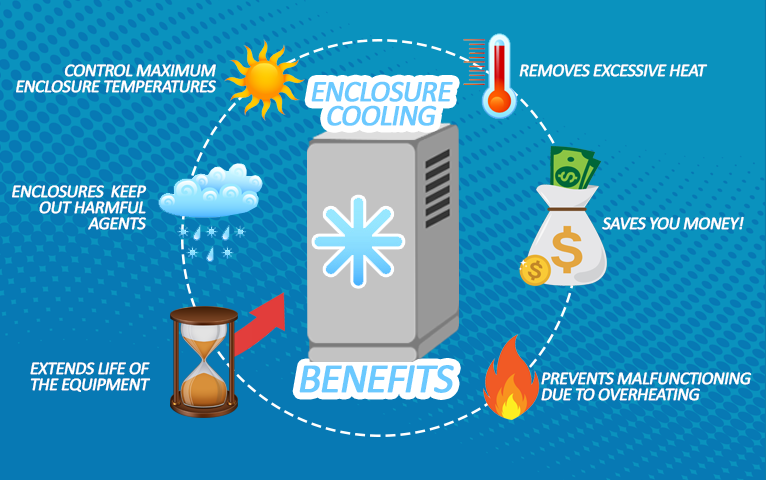
- Control Maximum Enclosure Temperatures – Panel coolers keep your system from feeling “hot, hot, hot.” Few devices can be used above 120 degrees Fahrenheit and many are limited to 105 degrees Fahrenheit. Average summer temperatures in the US can be 105 degrees or more. With additional heat created by solar radiation and other factors, your equipment could easily be in a damaging environment.
- Enclosures Keep Out Harmful Agents – Dirt, debris, dust, corrosive vapors and water can all be detrimental to expensive electrical equipment. Enclosure coolers help protect equipment from substances that can cause harm, preventing system failure and expensive repairs.
- Extends Life of the Equipment – Research has shown that for every 18 degrees above normal room temperature (72-76 degrees), the reliability of electrical components is reduced by half. Over-exerting components in a hot environment leads to a shorter life span for your equipment and costly repairs.
- Prevents Malfunctioning Due to Overheating – Keeping the enclosure at optimal operating temperatures will prevent over usage and will extend the life of your equipment exponentially.
- Removes Excessive Heat – Less heat will result in fewer problems. With no excessive heat, there will be no unnecessary repairs due to overworking the system.
- Saves You Money! – This is probably the most exciting benefit of adding a panel cooler to your system. Eliminating the problems associated with high heat will save you money by protecting your expensive electrical equipment from failure and expensive repairs associated with an over-exerted system.
All electrical systems give off heat and the environment where the enclosure is located can also add to a higher heat load.
Internal Heat Sources Include:
- AC Drives/inverters
- Battery back-up systems
- Communication gear
- PLC systems
- Power supplies
- Routers and switches
- Servers
- Transformers
External Heat Sources Include:
- Blast furnaces and foundries
- Engine rooms
- Food processing factories
- Industrial Ovens
- Hot Climates
- Manufacturing plants
- Outdoor solar heat gain
- Uninsulated or non-air conditioned buildings
How to Determine Which Enclosure Cooler Will Work for You
NEMA Ratings:
The National Electrical Manufacturer’s Association (NEMA) ratings explain what the enclosure’s intended use is for, from small pushbutton boxes to large full sized room enclosures.
NEMA ratings standardize product specifications while establishing performance criteria.
In other words, they make sure consumers are buying the right enclosure to keep electrical components safe based on the cabinet’s environment and type of equipment inside.
It is important for the panel cooler to have the same NEMA rating as the electrical enclosure. If the panel cooler and the enclosure have different ratings it will not meet NEMA standards. This is a bad thing because your electrical equipment will not get the correct protection that it needs.
BTUH Calculator:
Using a BTUH calculator is the perfect solution to enclosure ac sizing. It does most of the work for you, and who doesn’t love a shortcut?
The ISC Sales BTUH calculator takes all of these factors into account when calculating heat loads:
- Enclosure Dimensions: A large enclosure will need more cooling power than a small enclosure.
- Environmental Temperatures:
To accurately read ambient temperatures for indoor enclosures:
-
-
- Measure the temperature far enough away from your cabinet so your reading will not be skewed by heat radiating from the enclosure, at least 20 feet away
- Take multiple measurements throughout the day and use the highest recorded temperature as a guideline. Make sure you are recording temperatures during peak operation time when all equipment is running.
- Use a calibrated thermometer.
-
For outdoor enclosures…
-
-
-
- Don’t measure the surface temperature of the cabinet. This will give you a higher reading because it is affected by heat from the sun and cooling from the shade.
- Think about seasonal changes in the area and use the highest expected temperature. You can find accurate regional figures by visiting weather websites like this one Weather.gov
- Use a calibrated thermometer.
-
-
- Heat Load: To calculate heat load, make a list of all the equipment in the cabinet, paying special attention to the manufacturer’s model numbers. Use this information to look up the amount of heat in watts that each component generates, then add it all up to get the heat load.
*If you can’t find the numbers in watts, but you know the horsepower (HP) remember that 1HP= 746 W. *
- Enclosure Materials: Enclosures made of aluminum have different NEMA ratings than polycarbonate ones and they can protect against different environments. They also have different cooling needs.
- Insulation: Just like wrapping yourself up in a blanket, insulation can trap heat in. This is an advantage for enclosures located in climates with cold winters. However, the insulation can create problems during warmer weather if it is not considered while deciding on which enclosure cooler will work best for you.
- Location: Whether the enclosure is inside, outside, in an air-conditioned environment, in direct sunlight or near high-heat producing equipment can all affect internal temperatures in the cabinet.
- Ambient Air Conditions: The air surrounding the enclosure plays an important role in deciding which enclosure cooler works best.If harmful, potentially explosive dust entering the cabinet is a concern the enclosure will need a different cooler type than if you simply needed a cooler to protect components from the high temperatures of an outdoor climate.
- Paint Color: Darker colors will trap heat, while lighter colors will not.
These factors are all crucial for determining which enclosure will best work for your application. An incorrect heat calculation can result in using the wrong cabinet cooler.
Using the wrong cooler will keep your equipment from working at its best. Components will overload, leading to expensive repairs and you will experience the same problems that led you to purchase a cooler.
Types of Enclosure Coolers
Enclosure coolers are separated into two categories based on how much they can lower internal temperatures in an electrical cabinet.
Every Above Ambient system and every Sub-Ambient system cool enclosures differently and are for wide-ranging applications and environments.
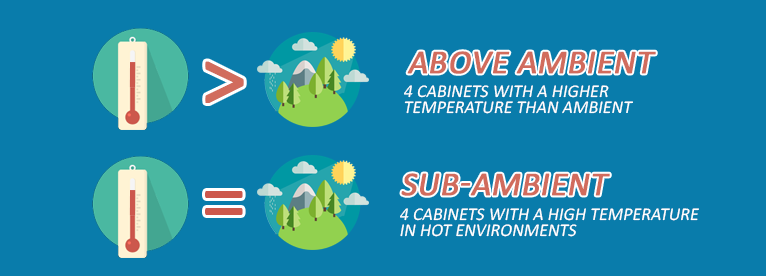
Above Ambient
These enclosure coolers work best for electrical cabinets that have a higher internal temperature than the environment around it.
Above Ambient systems can only be used when the ambient, or surrounding, temperature is lower than the desired enclosure temperature.
This means that these systems do not actively make your enclosure colder, they simply circulate the hot air in the enclosure with the cooler air present in the environment around it. Sometimes you don’t need all the bells and whistles and just need a simple solution.
An enclosure in a well air-conditioned environment where the average ambient temperature is 76 degrees is an ideal situation for an Above Ambient cooler.
Above Ambient coolers tend to be less pricey, but have a limited cooling capacity.
Fan Filter:
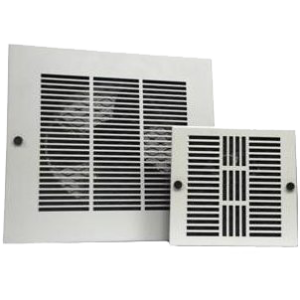
Fans and grills work together to displace hot air inside the enclosure with cooler air. Incoming air is filtered to protect components from dust and debris.
These systems work just like a fan you’d use inside your home. They do not physically lower the temperature of your home, but they do move and cycle air creating a cooler climate and have the added bonus of filtration.
Pros:
- Works well in temperature controlled environment
- Simple, non-complex system
- Inexpensive option
Cons:
- Maintenance requires regular filter replacement
- Limited NEMA rating: water, dirt and other contaminants can still enter the enclosure
Air to Air Heat Exchanger:

Air to Air systems recirculate the air in the enclosure. Heat is transferred using a heat pipe running from the hot enclosure to cooler ambient air.
The heat pipe is a sealed tube filled with a very low-pressure refrigerant liquid. The bottom of the pipe is warmed by the hot air in the cabinet, causing the refrigerant to vaporize and rise to the top of the pipe.
The top of the pipe comes into contact with cooler ambient air. Once the refrigerant hits the cooler air it releases its heat, condenses and then returns to the bottom of the pipe. Small fans are also used circulate the air inside and blow outside air over the heat pipe.
Air to Air Heat Exchangers function with a close looped design, meaning they recirculate the air already present in the enclosure, which prevents water, dirt and other contaminants from entering the cabinet.
Even though heat is transferred between inside and outside air they never come into contact with each other.
The cool top and warm bottom of the pipe are in separate compartments. The bottom is completely sealed, allowing only hot air from the top to enter the heat exchanger and the cool air to return to the enclosure. The top compartment is exposed to the ambient air circulated by a fan, discharging heat.
Pros:
- Works well both indoors and outdoors
- Can be used with NEMA rated enclosures
- Extremely reliable, heat pipe assembly usually lasts 300,000 hours or more
- Minimal maintenance, inexpensive
Cons:
- Cannot cool below ambient temperatures
- Must be installed vertically
Sub-Ambient
These types of enclosure coolers are the best for enclosures with a high heat load in an environment that is also hot.
Sub-ambient coolers actively lower temperatures inside of the enclosure to below ambient temperatures.
A cabinet located outside of a manufacturing plant in the Nevada desert is an example of when a Sub-Ambient cooling system would be best. The environmental temperature of the Mojave Desert routinely reaches temperatures 100 degrees Fahrenheit by the beginning of May. Whew! Talk about hot!
Typically, these systems have a higher cost but in return provide greater cooling power.
Enclosure Air Conditioner Units:

Enclosure air conditioning units work like your ac unit inside your home. They cool enclosures using this principle- fluid heats up when compressed and cools when it is expanded.
A high-temperature/high-heat gas is created when a vaporized refrigerant is compressed. The gas is then shot through a series of coils while a fan blows ambient air across them. This removes the heat from the gas, transferring it to the surrounding environment and returns the gaseous refrigerant to liquid.
Then the refrigerant passes through an expansion valve where it becomes cold as it is expanded and evaporated before going into the evaporator coil. Air from inside the cabinet is then blown across the evaporator coil by another fan, moving the heat from the electrical components to the refrigerant. Finally, the vaporized refrigerant returns to the compressor where the process begins again.
Pros:
- High cooling capacity
- Compatible with many applications
- Units range from 1,000 BTUH to 20,000 BTUH
Cons:
- More maintenance: replacing filters, checking condenser coils for scale and other buildup (Delta T enclosure ACs include a condensate elimination system that will reduce the need for maintenance)
- Horizontal or vertical orientation only/stationary
Thermoelectric Air Conditioner or Peltier Coolers:

Thermoelectric cooling uses the Peltier effect to create a temperature difference by transferring heat between two electrical junctions. A voltage is applied across joined conductors to create an electrical current.
When the current flows through the intersection of the two conductors, heat is removed at one junction and cooling occurs. Heat is then deposited at the other junction.
Finally, the hot side is attached to a heat sink which remains at ambient temperatures, while the cool side drops below room temperature.
Pros:
- No moving parts or circulating liquid
- Environmentally friendly, it doesn’t require the use of potentially harmful coolants
- Can also be configured to generate heat during colder seasons
- Long life with little to no maintenance
Cons:
- Limited cooling capacity
Vortex Coolers and ACs:
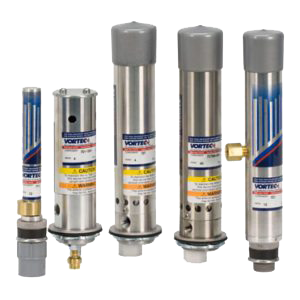
Vortex coolers’ primary component is a Ranque-Hilsch vortex tube. This device’s cylindrical generator uses compressed air to create a swirling effect that separates air into hot and cold air streams.
Compressed air enters a chamber in the vortex tube and is forced to spin in a tight, high-speed circular path at one million revolutions per minute, like a tornado. At the end of this tube is a needle valve where a small portion of the air exits as hot air exhaust.
The remaining air is forced back through the center of the incoming air stream at a slower speed. The heat in the slower moving air transfers into the faster moving incoming air.
The cooled air flows through the center of the generator and exits through a cold air exhaust point. Only 40 percent of air is lost into the atmosphere through exhaust valves, while the remaining 60 percent cools the enclosure.
This process provides a positive purge, pressurizing the enclosure. This pressure will keep out contaminants such as dirt, dust, and debris.
Both vortex coolers and vortex air conditioning units utilize this technology. The main distinctions between the two are their shape and the type of thermostat used to regulate them. Vortex coolers are cylindrical in shape. They are fitted with an electrical thermostat to precisely regulate the cabinet’s internal temperatures.
Vortex air conditioners are shaped like a box, self-contained and have a mechanical thermostat. They run quieter than coolers and are generally easier to install.
Pros:
- Suitable for harsh or hazardous environments
- Little to no maintenance
- No moving parts, which means a long life
Cons:
- Needs clean/dry compressed air
Helpful Additions
Purge/Pressurization Systems:
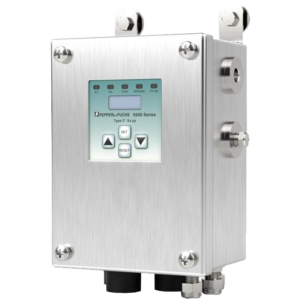
Purging and pressurization systems are one of the most versatile options for explosion protection. They can be used with any enclosure cooler in hazardous locations. Purge and pressurization systems prevent things from going “boom” by first purging or removing, the flammable gasses that could explode.
After the purge, compressed air or inert gas fills the enclosure, which prevents any potentially flammable ambient air or dust from entering the cabinet through any leaks. This pressurization, using a non-reactive gas, limits the chances of an explosion due to interactions with ambient air or dust.
For systems that need protection from dust, the purge process is omitted to prevent raising explosive dust. Instead of purging, the interior is inspected for dust, and if it is present the cabinet is then cleaned manually.
Before you add a purge/pressurization system to your enclosure be sure to define your hazard, know the classification of the area, ratings of the equipment inside the enclosure, type of enclosure; the position of doors, windows and any accessories, and how much power the electrical equipment inside uses.
Pros:
- Versatile applications, they can be added to almost any system
Cons:
- They need a constant source of compressed air
Still unsure of which enclosure cooler will fit your needs?
Needs vary so much from application to application it is hard to determine what will work best.
But you’re in luck! The staff at ISC Sales is very knowledgeable, able to answer any of your questions and will ensure that you get the most efficient product for your business. Contact us today and have the enclosure cooler that’s perfect for you tomorrow.


